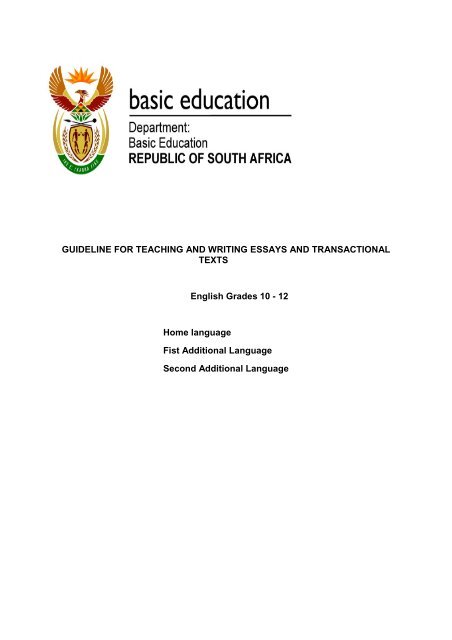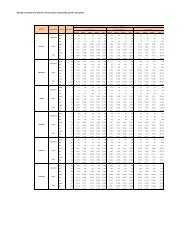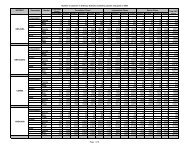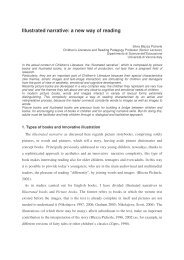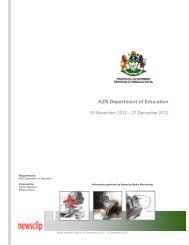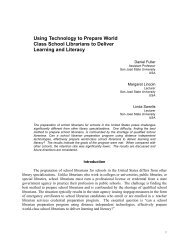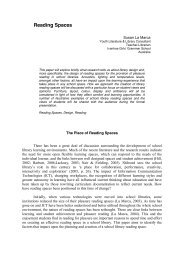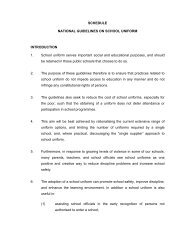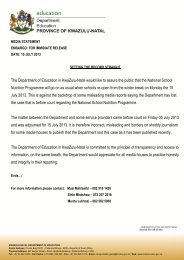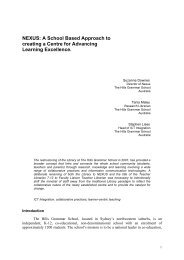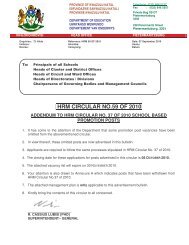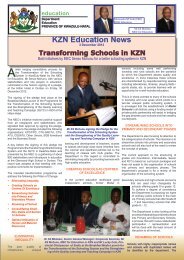GUIDELINE FOR TEACHING AND WRITING ESSAYS ... - Thutong
GUIDELINE FOR TEACHING AND WRITING ESSAYS ... - Thutong
GUIDELINE FOR TEACHING AND WRITING ESSAYS ... - Thutong
Create successful ePaper yourself
Turn your PDF publications into a flip-book with our unique Google optimized e-Paper software.
<strong>GUIDELINE</strong> <strong>FOR</strong> <strong>TEACHING</strong> <strong>AND</strong> <strong>WRITING</strong> <strong>ESSAYS</strong> <strong>AND</strong> TRANSACTIONAL<br />
TEXTS<br />
English Grades 10 - 12<br />
Home language<br />
Fist Additional Language<br />
Second Additional Language
CONTENTS<br />
TYPE OF TEXT<br />
PAGE<br />
1. Introduction 4<br />
2. Process writing 4<br />
3. Essays: Kinds of essays 5<br />
3.1. Narrative essay 5<br />
3.2. Descriptive essay 6<br />
3.3 Expository essay 6<br />
3.4 Argumentative essay 7<br />
3.5. Discursive essay 7<br />
3.6. Reflective essay 8<br />
4. Transactional Writing<br />
9<br />
4.1 Longer Transactional Texts<br />
4.1.1. Official letter 9<br />
4.1.2. Friendly letter 11<br />
4.1.3. Internal Memorandum 12<br />
4.1.4. Writing a short article 15<br />
4.1.5. Agenda and minutes of the meeting 15<br />
4.1.6. Speech 18<br />
4.1.7. Dialogue 19<br />
4.1.8. Interview 20<br />
4.1.9. Review 21<br />
4.1.10. Newspaper article 22<br />
4.1.11. Magazine article 23<br />
4.1.12. Newspaper column 24<br />
4.1.13. Curriculum Vitae (CV) 25<br />
4.1.14. Obituary 27<br />
4.1.15. Brochure 28<br />
4.1.16 Editorial 29<br />
2
4.2. Shorter Transactional Texts 30<br />
4.2.1. Invitation 30<br />
4.2.2. Diary 31<br />
4.2.3. Post card 32<br />
4.2.4. Direction 32<br />
4.2.5. Instructions 34<br />
4.2.6. Advertisement 34<br />
4.2.7. Flyer 35<br />
4.2.8. Poster 36<br />
4.2.9. Filling in a form 38<br />
4.2.10. Writing an email 38<br />
4.2.11. Sending a Fax 40<br />
3
1. INTRODUCTION<br />
The purpose of this guideline is to briefly guide teachers and learners on the aspects of<br />
writing and presenting. Furthermore, the guideline presents and shares information with<br />
regards to producing various texts and their uses. This will enable learners to attain and<br />
successfully demonstrate Learning Outcome 3 (LO 3), which aims to ensure that ‘The learner<br />
is able to write and present for a wide range of purposes and audiences using conventions<br />
and formats appropriate to diverse contexts.’<br />
This guideline may be used by teachers and learners of English Home, First and Second<br />
Additional Languages. The document will also enable learners to prepare for the Writing<br />
Paper (Paper 3) which requires learners to choose and write three of the various writing texts<br />
dealt with during the course of the year.<br />
2. PROCESS <strong>WRITING</strong><br />
Writing and designing texts is a process and learners need the opportunity to put this<br />
process into practice. They should:<br />
• decide on the purpose and audience of a text to be written and/or designed;<br />
• brainstorm ideas using, for example mind maps, flow charts or lists;<br />
• consult relevant sources, select relevant information and organise ideas;<br />
• produce a first draft which takes into account purpose, audience, topic and genre;<br />
• read drafts critically and get feedback from others (classmates);<br />
• edit and proofread the draft;<br />
• produce a well-designed final version.<br />
Note!<br />
●<br />
●<br />
●<br />
●<br />
●<br />
Learners should write every day. Learners should often be given the opportunity to<br />
write freely without an assessment requirement.<br />
In more formal writing, teachers are advised to assess a particular skill or sub-skill<br />
being dealt with during that particular stage of the process. For example, all language<br />
skills need not be addressed during each step of the process.<br />
Peers should also learn to edit one another’s work as this interaction is an important<br />
part of the process of writing and improves own and other’s awareness of the<br />
process.<br />
An important aspect of this Learning Outcome is the presentation of written work. It<br />
can be shared with peers, teachers, the school as a whole, parents and/or a wider<br />
range of stakeholders. The learner should take pride in a rounded, complete product.<br />
Learners should be informed about the characteristics and requirements of different<br />
kinds of creative texts. A short description of the kinds of writing texts that learners are<br />
required to produce is provided below.<br />
4
3. <strong>ESSAYS</strong><br />
An essay is an extended piece of writing, in which a writer expresses his/ her point of view on<br />
the topic given.<br />
The length of texts ranges from:<br />
• 200 – 250 words for English Second Additional Language;<br />
• 250 – 300 words for English First Additional Language; and,<br />
• 400 – 450 words for English Home Language.<br />
An essay should have an introduction, body and conclusion. A brief explanation of each<br />
follows:<br />
• Introduction<br />
The introduction should catch the reader’s attention, define the topic and briefly tell the<br />
reader what the essay will be addressing.<br />
• Body<br />
The body comprises the full content of the essay. The body must be divided into paragraphs,<br />
each of which must pursue a specific idea to the end. The writer must address all the ideas<br />
he or she wanted to address, keeping to the topic.<br />
• Conclusion<br />
The conclusion is the ending, the rounding-off of the presentation. This should tie up all that<br />
was presented by the writer, a parting shot that justifies the writer’s point of view. As this is<br />
the end, the writer must not bring in new information.<br />
Learners must be taught how to write – and must write - the following kinds of essays:<br />
3.1 Narrative essay<br />
A narrative essay tells a story or tells of a past event. It can be written from any perspective.<br />
Example topics:<br />
●<br />
●<br />
We were having a wonderful time. There was good food, good music and good<br />
company. Suddenly there was an earth-shaking crash. Write about the incident.<br />
The best story my grandfather told me.<br />
Consider the following when writing a narrative essay:<br />
●<br />
●<br />
●<br />
●<br />
●<br />
●<br />
●<br />
●<br />
The story must have a strong story line and be convincing even if it is fiction.<br />
A narrative essay is usually written in the past tense.<br />
The introductory paragraph should capture the reader’s attention.<br />
A good story often has a point to make.<br />
An unusually interesting ending gives a story the final touch.<br />
The reader’s interest must be maintained until the end. The style, rhetorical devices<br />
and action must ensure sustained interest.<br />
A successful narrative vividly highlights sensory details such as sight, sound, taste,<br />
smell and tactile sensations.<br />
A narrative essay often has a strong descriptive element.<br />
5
3.2 Descriptive essay<br />
In a descriptive essay, the writer describes something to allow the reader to experience the<br />
topic being described as vividly as possible. Someone or something can be described.<br />
Example topics:<br />
●<br />
●<br />
The dentist’s waiting room. Describe your feelings and impressions.<br />
Describe a stormy night.<br />
Consider the following when writing a descriptive essay:<br />
●<br />
●<br />
●<br />
●<br />
●<br />
The writer should create a picture in words.<br />
Words and expressions are chosen carefully to achieve the desired effect.<br />
Images of sight, sound, hearing, taste and touch can be used to make the description<br />
vivid.<br />
Figures of speech are used in original ways.<br />
Learners should ideally have experience of the topic. It is very difficult to describe<br />
something without having firsthand knowledge.<br />
3.3 Expository essay<br />
Expository writing communicates ideas or information in a logical way. This is a factual essay<br />
in which the writer explains ideas or gives facts in a systematic way. An expository essay is<br />
well researched and ideas are supported by facts and figures.<br />
Example topics:<br />
●<br />
●<br />
More than a thousand people are killed in road accidents during the December<br />
holiday. How can this carnage on our roads be stopped?<br />
Discuss how you would go about collecting funds for the matric farewell party.<br />
Consider the following when writing an expository essay:<br />
●<br />
●<br />
●<br />
●<br />
●<br />
A thorough understanding of the topic is required.<br />
Good research is vital as statements have to be supported by facts.<br />
As the reader may not have a specialised understanding of the topic, the writer should<br />
clarify any concepts which may be unfamiliar.<br />
Ideas must be organised logically and take the reader from the known to the<br />
unknown.<br />
An expository essay is generally written in the present tense.<br />
6
3.4 Argumentative essay<br />
In an argumentative essay, the writer has a specific opinion or viewpoint and argues to<br />
defend or motivate his or her position. The opinion of the writer should be clear throughout.<br />
This is a subjective essay in which the writer tries to convince the reader to share his or her<br />
point of view.<br />
Examples topics:<br />
●<br />
●<br />
Television kills creativity. Do you agree?<br />
The future of South Africa depends on foreign investment. Give your views.<br />
Consider the following when writing an argumentative essay:<br />
●<br />
●<br />
●<br />
●<br />
●<br />
●<br />
The essay should start with the writer’s view of the topic in an original and striking<br />
way.<br />
The writer should give a range of arguments to support and substantiate his or her<br />
view.<br />
The writer focuses on points for OR against a statement.<br />
An argumentative essay can be subjective and strong opinions are expressed. A<br />
variety of rhetorical devices and persuasive techniques should be used.<br />
The language used is emotive and can be emotional but should not be rude.<br />
The conclusion should be a strong, clear and convincing statement of the writer’s<br />
opinion.<br />
3.5 Discursive essay<br />
A discursive essay is objective and aims to give a balanced view of both sides of an<br />
argument. The writer considers various aspects of the topic under discussion and presents<br />
opposing views impartially. The writer may come to a particular conclusion at the end of the<br />
essay but the arguments for and against must be well balanced and clearly analysed in the<br />
course of the essay.<br />
Example topics:<br />
●<br />
●<br />
Write an essay in which you give arguments for and against abortion.<br />
Learners should be able to choose their own prescribed books for literature. Discuss<br />
this statement looking at both sides of the argument.<br />
Consider the following when writing a discursive essay:<br />
●<br />
●<br />
●<br />
●<br />
The writer should understand and be able to reflect both sides of the argument in an<br />
impartial and well informed way.<br />
The writing must be lucid, rational and objective. Calm, well-reasoned and wellsupported<br />
statements should be made.<br />
The tone should be unemotional and convincing without being condescending.<br />
The writer may give an indication of his or her opinion at the end of the essay but this<br />
should only be done in conclusion.<br />
7
3.6 Reflective essay (Home and First Additional Language)<br />
In a reflective essay the writer contemplates an idea and gives his or her emotional reactions<br />
and feelings. The writer could, for example, reflect on dreams or aspirations.<br />
Examples topics:<br />
●<br />
●<br />
This is how I remember the best teacher I ever had.<br />
Give your views on life and how it should be lived.<br />
Consider the following when writing a reflective essay:<br />
●<br />
●<br />
●<br />
●<br />
A reflective essay is subjective.<br />
Feelings and emotions play a major role.<br />
A substantial part of the essay may be descriptive. These descriptions should be vivid<br />
and aim to recreate recollections or feelings of the writer in the reader.<br />
The ideas, thoughts or feelings expressed should reveal sincerity and personal<br />
involvement.<br />
Food for thought:<br />
While the various essay kinds seem independent of each other, it would be interesting to<br />
follow how the stages involved to produce one could be the brainstorming sessions for the<br />
subsequent ones. For an example, should the narrative not form the base for a description?<br />
Could one not argue in favour of one’s description of an item, or, having compared one’s<br />
description of the same to another’s, come to an evaluation of some sort?<br />
Taking it into the transactional texts, could a newspaper article not be a result of an interview,<br />
a dialogue a result of a speech, a diary entry a summary of all that took place during the day,<br />
among others?<br />
The moral of the story:<br />
Although all texts have each, their own identity, they are each a product of a spread of other<br />
texts.<br />
The challenge is for learners and teachers to put this in practice.<br />
8
4. TRANSACTIONAL TEXTS<br />
Transactional writing texts are either a response or an initiation of a response. As implied,<br />
these are ‘transaction texts’ - a friendly letter of appreciation will possible yield a response,<br />
as much as a speech will get the audience won over or yelling in disagreement.<br />
Transactional texts are divided into Longer and Shorter texts. The kinds of texts are listed<br />
and explained below:<br />
4.1 LONGER TRANSACTIONAL TEXTS<br />
The length of texts ranges from:<br />
• 80 – 100 words for English Second Additional Language;<br />
• 120 – 150 words for English First Additional Language; and,<br />
• 180 – 200 words for English Home Language.<br />
Official/ Formal letter<br />
There are different kinds of formal letters, e.g. a letter of application, a letter to the editor of a<br />
newspaper, a letter of complaint, etc.<br />
While the letters may set different requirements for the writer, the following are applicable to<br />
all of them:<br />
• Style<br />
The formal letters must be written in direct, simple English. The writer must keep in<br />
mind that the intended audience should understand what is communicated for the<br />
results/ response to be positive.<br />
The letter should be …<br />
• Structure<br />
‣ clear and straightforward – the recipient must not be left wondering at what<br />
you are trying to communicate;<br />
‣ concise and to the point; and<br />
‣ logical.<br />
‣ All letters should have an introduction, a body and a conclusion.<br />
‣ There must be two addresses, the writer’s and the recipient’s;<br />
‣ A formal salutation – Dear Sir, Dear Mrs Bukov, etc. - follows the recipient’s<br />
address;<br />
‣ A title or subject line follows the salutation. This is a one-line summary of the<br />
letter and should be underlined;<br />
‣ The language register must be formal;<br />
‣ The conclusion must also be formal – Yours faithfully – followed by the<br />
writer’s surname and initials.<br />
• Issues to avoid<br />
‣ Slang and colloquial language;<br />
‣ Contractions, abbreviations and acronyms;<br />
‣ Unsubstantiated accusations, threats that cannot be carried out, emotional<br />
language, sarcasm, clichés, etc.<br />
9
Examples of formats of Formal letters.<br />
1. Letter to the Editor 2. Application for a vacant post<br />
The Editor<br />
City Post Magazine<br />
79 Sort Street<br />
Pretoria<br />
27 Lechwe Street<br />
Fauna<br />
9301<br />
12 February 2010<br />
0001<br />
XXXX OPEN LINE<br />
Sir/ Madam<br />
XXX OPEN LINE<br />
BIASED JOURNALISTS RUN OUR COUNTRY TO THE GROUND<br />
XXX OPEN LINE<br />
XXXXXXX OPEN LINE<br />
The Manager<br />
City Groove Magazine<br />
55 Tabloid Street<br />
Bloemfontein<br />
9300<br />
The current cohort of journalists ……………………….<br />
……………………………………………………………..<br />
…………………………………………………………….<br />
XXXXXXXXXX OPEN LINE<br />
Sir/ Madam<br />
XXX OPEN LINE<br />
APPLICATION <strong>FOR</strong> A VACANT POST<br />
XXX OPEN LINE<br />
Kindly receive herewith, my application for the<br />
XXXX OPEN LINE<br />
post of ……………………………………………...<br />
I hope someone speaks to them about being a patriot.<br />
XXXXXX OPEN LINE<br />
XXXXXX OPEN LINE<br />
Concerned citizen<br />
Kihika (pseudonym)<br />
OR<br />
Yours faithfully<br />
Keabetswe K.<br />
Yours faithfully<br />
Katlego K. (Ms)<br />
Katlego K.<br />
Keabetswe K.<br />
12 Macumba Street<br />
12 Macumba Street<br />
BLOEMFONTEIN<br />
BLOEMFONTEIN<br />
9300<br />
9300<br />
12 February 2010<br />
12 February 2010<br />
10
Friendly/ Informal letter<br />
Friendly/ Informal letters are usually written to people who are close to the writer, e.g. friends,<br />
family, etc. They mainly written to express an emotion, e.g. congratulate, sympathise, advise,<br />
etc. the recipient. Due to the nature of the relationship between the writer and the recipient,<br />
the language register and style, among others, differ from those of the formal letter.<br />
• Style<br />
Like the formal letters, informal letters must also be written in simple English.<br />
However, the writer may elaborate a little on a point, for example, reminding the<br />
recipient about a shared moment that might have partially led to the letter being<br />
written. While there is a restriction on the number of words, the writer is allowed a<br />
little flamboyance. Informal letters are, as a result, livelier than formal letters.<br />
The letters should, nonetheless, be logical and pursue the intended point to the end.<br />
• Structure<br />
‣ All letters should have an introduction, a body and a conclusion.<br />
‣ There must be only one address, the writer’s, with a date in which it was<br />
written below it;<br />
‣ An informal/semi-formal salutation – Dear Jerry, Dear Aunt Juliet, Dear<br />
Father and Mother, etc. - follows the writer’s address;<br />
‣ The language register is mainly informal, but could be semiformal to formal,<br />
depending on who the recipient is. For example, the writer will use a different<br />
register when writing to parents compared to that used when writing to a<br />
friend;<br />
‣ The conclusion ranges from informal to semi-formal – Yours sincerely; Your<br />
loving son; etc – followed by the writer’s first name.<br />
• Issues to avoid<br />
While the language register is more relaxed than in the informal letter, the following still<br />
have to be avoided:<br />
‣ Slang and colloquial language;<br />
‣ Contractions, abbreviations and acronyms;<br />
‣ Innovations as used in sms and mxit texts; and,<br />
‣ Foul language.<br />
11
Examples of informal letters.<br />
1. Letter to a friend 2. Letter to an uncle<br />
621 Nelson Mandela Drive<br />
Pretoria<br />
0001<br />
15 June 2010<br />
27 Lechwe Street<br />
Fauna<br />
9301<br />
12 February 2010<br />
XXXX OPEN LINE<br />
Dear John<br />
XXXX OPEN LINE<br />
Ever heard about tales around the evening fire? Well, my<br />
friend, what I am going to tell you is not one of this tales, and<br />
neither is it a tall story.<br />
XXXX OPEN LINE<br />
My uncle Tall single-handedly saved a lamb from the jaws of a<br />
marauding lion…<br />
XXXXXXX OPEN LINE<br />
Dear Uncle Tall<br />
XXXXXXX OPEN LINE<br />
It gives me great pleasure to write this letter to you, my loving<br />
uncle. I have you have fully recovered use of your right hand<br />
since the encounter with the lion. Everybody at school knows<br />
about my brave uncle.<br />
XXXXXXX OPEN LINE<br />
We have been given a Life Orientation project in which we<br />
must identify someone in the community who can be referred<br />
to as a hero and interview them. Having heard about your<br />
brave deed, my group thinks that you deserve the honour and<br />
requests permission to interview you…<br />
I know you find it hard to believe what I told you. My uncle has<br />
agreed to be interviewed by my group for the Life Orientation<br />
project. I invite you to come with us so that you can get it from<br />
horse’s mouth.<br />
I look forward to your reply.<br />
On behalf on the group, I look forward to your positive<br />
response to our request.<br />
Yours sincerely<br />
Chana<br />
Your loving nephew<br />
Smiley<br />
Memorandum<br />
This is a document used for communication within a particular institution or company. It may<br />
come from one department to the other or one section to another, within the company among<br />
related companies.<br />
A memorandum is used, among others, to convey requests, arrangements, complaints,<br />
notice of meeting, suggestions, etc.<br />
12
The following items are essential in writing a memorandum:<br />
• The name of the company/institution on top;<br />
• The word MEMOR<strong>AND</strong>UM, in capital letters (and in bold if typed), below the name of<br />
the company;<br />
• The preposition TO: followed by the target audience;<br />
• The preposition FROM: followed by the writer – only the writer’s position is given;<br />
• The DATE in which the memo was written;<br />
• HEADING, normally in capital letters (and in bold if typed); and,<br />
• The SIGNATURE or INITIALS of the writer, at the end.<br />
The content must always be simple and concise, preferably written in simple English.<br />
Although the writer does not start with any form of salutation/ greeting, the document is<br />
always rounded with a cordial conclusion, e.g. I thank you for your cooperation.<br />
See example below:<br />
See examples of internal memorandum:<br />
WINNERS DRAMA SOCIETY<br />
___________________________________________________________________<br />
MEMOR<strong>AND</strong>UM<br />
TO<br />
FROM<br />
: Actors<br />
: Producer<br />
DATE : 18 June 2010<br />
RE: POSTPONEMENT OF PRACTICE SESSION<br />
Take note that the 15h00 practice session will not take place as scheduled this afternoon.<br />
The practice venue will be utilised by the Bafana Bafana team for a pep-talk in preparation<br />
for the France game on Tuesday.<br />
We are commissioned to provide entertainment for the team on Sunday, 15h00. In order to<br />
put final touches to our game, you are expected at the practice venue on Saturday, 19 June<br />
2010, at 09h00. This practice session may be longer than all others because of the Sunday<br />
event.<br />
Make good use of your free afternoon.<br />
Kind regards<br />
BBravsa<br />
Barras Brava<br />
Producer<br />
13
Example 2<br />
MATRIX 20TURN<br />
_________________________________________________________________________________<br />
_<br />
MEMOR<strong>AND</strong>UM<br />
TO<br />
: Members<br />
FROM : Ralph<br />
DATE : 18 June 2010<br />
RE: GUEST LECTURER<br />
_________________________________________________________________________________<br />
__<br />
The Matrix 20Turn Committe invites you to an interactive presentation of W. Golding’s Lord of the<br />
Flies, on Monday, 21 June 2010, from 09h30 to 15h00. Mr. Macbeth ‘Piggy’ Seoul, a renowned<br />
playwright and prolific English teacher, will be the guest presenter for the day. After the presentation,<br />
our guest will analyse previous question papers on the novel, and give coaching on how questions<br />
should be answered.<br />
You are urged to confirm attendance with your ‘ward leader’ so that appropriate catering<br />
arrangements can be made.<br />
See you there<br />
ralphdoxz<br />
R. Doxier<br />
Chairperson: Matrix 20Turn<br />
14
A short article<br />
This is a text that gets to the point. Only the salient points are mentioned. There is no room<br />
for elaborations or extended opinions. The writer only mentions what he/she intends to<br />
communicate and stops.<br />
See example below.<br />
STORMERS BACK IN SECOND PLACE<br />
The Vodacom Stormers bounced back with an important 33 – 21 win over the Blues in<br />
Auckland yesterday.<br />
The Stormers conceded more than two tries, and they missed an astonishing number of<br />
tackles against a Blues team that was forced to play catch-up from an early stage of the<br />
match.But with the pack laying the platform, and the back row, lock Andries Bekker and<br />
hooker Tiaan Liebenberg in particularly impressive form, the Cape team thoroughly<br />
deserved to win.<br />
They’re back into the second place on the log.<br />
Source: Sunday World, 11 April 2010<br />
Supersport.com<br />
Agenda and minutes of the meeting<br />
An agenda gives an outline of what is to be discussed at a meeting. It is normally given<br />
beforehand to people/delegates who are invited to a meeting. The agenda is usually drawn<br />
up by the chairperson and the secretary, who, among others...<br />
• Check minutes of the previous meeting for items that were carried over;<br />
• List and collect items that the meeting may need to address; and,<br />
• Invite members/delegates to forward items they want discussed.<br />
The chairperson and the secretary arrange the items according to their importance<br />
beforehand, and then make the final agenda available to the members/delegates. When the<br />
final agenda is circulated/availed, the chairperson shall have determined how much time<br />
would be allocated to each item.<br />
15
The following items are common:<br />
1. Opening and Welcome<br />
2. Apologies<br />
3. Reading and adoption of minutes of previous meeting<br />
4. Matters arising<br />
5. New matters<br />
eports<br />
eedback from stakeholders<br />
6. Date of next meeting<br />
7. Closure<br />
The minutes of a meeting are a record of what happened at a meeting. The minutes have to<br />
be adopted as a true record in the following meeting for them to be binding, and remain so<br />
until they can be revoked.<br />
The minutes:<br />
• Reflect the name of the organisation;<br />
• Show the date, the place and the time at which the meeting was held;<br />
• State the name of the people who attended the meeting – can be added as an<br />
annexure, attendance register;<br />
• Quote resolutions word for word;<br />
• Provide a summary of what was proposed and finally agreed upon;<br />
• Are written in the past tense;<br />
• Leave out trivialities like jokes;<br />
• Only become legal and binding once signed and dated by the chairperson after being<br />
read and adopted in the next meeting.<br />
16
An example of the minutes of a meeting<br />
Minutes of a Grade 12 Literature Study Group<br />
Venue: Central Library Gardens<br />
Date: 12 April 2010<br />
Time: 09h00<br />
Attendance: See attached register<br />
Apologies: Thato Mokoena who was in detention; Marylyn Macvy who was<br />
absent due ill-health; Groovy Fourie and Styles Maphoo who had attended rugby<br />
and soccer tournaments respectively.<br />
1. Mr Toffolux, the chairperson, welcomed all the members.<br />
2. The minutes were read and adopted as a true reflection of what<br />
transpired in the previous meeting.<br />
3. Matters arising<br />
3.1<br />
3.2<br />
4. New matters<br />
4.1 Preparations for the literature test were presented by Ms Loud. The<br />
meeting accepted the presentation. Ms Loud was commended for the good<br />
work.<br />
4.2 The chairperson presented a plan to invite Mr Shakespeare, the<br />
author of the drama Othello, to address the Study Group on the drama. The<br />
meeting appreciated the chairperson’s efforts. Ms Speaks volunteered to<br />
present a vote of thanks and a bouquet of flowers to Mr Shakespeare after<br />
the address.<br />
4.3 Mr Pokeman proposed that funds be raised to pay for expenses like<br />
buying a bouquet in the future. The meeting accepted the proposal. Mr<br />
Pokeman volunteered to lead the fund raising.<br />
4. The meeting closed at 09h45.<br />
5. The next meeting will take place at 14h30 at the Chimp cage foot on 18<br />
April 2010.<br />
NB: It is more correct to have the meeting CLOSE than ADJOURN.<br />
17
Speech<br />
When you write a speech, think about the following before you start and adapt accordingly:<br />
HOW: What style to use (serious, humorous, etc.? Will you placate, encourage, etc.? Will<br />
you be aggressive, gentle, truthful, diplomatic?<br />
WHEN: When are you speaking? The main speaker? After dinner, interval, in the morning,<br />
afternoon, evening?<br />
WHERE: At a christening, wedding, business lunch, school function. In a yacht, hall, lounge?<br />
Around a table?<br />
WHY: What is the purpose of the occasion? Why have YOU been invited to speak?<br />
WHO: Who will be there? How many? Young / older audience / athletes / businessmen/<br />
women?<br />
WHAT:<br />
• Show conviction, enthusiasm and self-confidence in the planning stage and it will show in<br />
your presentation.<br />
• A strong (clever) opener will attract attention<br />
• Develop your points well and avoid clichés.<br />
• Decide where you should pause and where to use gestures (naturally) and for what<br />
purpose. (Keep eye-contact.)<br />
• Use contrasting tones (and points) but remain audible.<br />
• Use fairly short sentences with simple ideas, using familiar examples.<br />
• Balance criticisms with reasonable alternatives.<br />
• Consider the closing. Leave the audience with a thought (or two).<br />
• Visual or physical aids may be used, but your words must come first.<br />
• You may use notes, but only for reference.<br />
• Avoid irritating mannerisms.<br />
• Use language that expresses your maturity, values and background. Swearing, crudity<br />
and profanity are unacceptable.<br />
See example below:<br />
Today, 20 July, a number of decades ago, a child was born. The scream, the yawn, the gentle<br />
snore – and he still snores Gloria tells me - decades later, has turned into an archetype of human<br />
perfection. A teacher, a father, a brother, a husband, a colleague and a preacher we celebrate<br />
today. Incredible you would say, that he is crying now. That is him, a cry baby.<br />
Our wish for you today, your birthday, is to strive to remain true to the course you did not choose,<br />
the course our Father mapped out for you. We pray that today will bring you closer and closer to<br />
attaining your dreams while remaining true to your course. You are the pride of our nation and an<br />
immeasurable measure of joy in our lives.<br />
May you be flooded with wealth, joy and happiness henceforth.<br />
Happy birthday my brother.<br />
18
Dialogue<br />
A dialogue is a conversation between two or more people. It is a record of the exchanges as<br />
they occur, directly from the speaker’s point of view.<br />
When writing a dialogue;<br />
• write the names of the characters on the left side of the page;<br />
• use a colon after the name of the character who is speaking;<br />
• use a new line to indicate each new speaker;<br />
• advice to characters (or readers) on how to speak or present the action must be given<br />
in brackets before the words are spoken;<br />
• sketch a scenario before you start writing.<br />
See example below.<br />
(Siphon and Thembyo have not completed a task given to them by their teacher. They are<br />
contemplating bunking the class.)<br />
Siphon: Good morning Thembyo?<br />
Thembyo: (wearing a frown) There is nothing good about this morning my friend. I hope<br />
yours is better.<br />
Siphon: If it is about the writing task we are expected to submit today, then you are not<br />
alone.<br />
Thembyo: (with a twinkle in his eyes) You know what?<br />
Siphon: I do not have to know anything. I know what that look means.<br />
Thembyo: Do you know me that much? My friend, you know what they say about<br />
desperate measures. Why don’t we bunk the English period. We can cook a<br />
better story to explain our absence than to sit in class and be told the failures we<br />
are.<br />
Siphon: Just why did I choose you for a friend. You have more tricks up your sleeve than<br />
the devil himself. Bunk classes? My answer is an emphatic no. I made my bed,<br />
so, I must lie in it.<br />
Thembyo: Ok ‘Mr Morals’. Let us see what Lisbeth, with whom you are so smitten, will<br />
think of you after the dressing down you will receive in class.<br />
Siphon: When is the English period again? I think I have spoken enough English today to<br />
miss out today’s.<br />
Thembyo: (with a victorious smile) And I thought I was the devil?<br />
Siphon: Do you have to rub it in?<br />
Thembyo: (with a grin on his face) By the way, you better have a good reason for our<br />
missing the class for the teacher tomorrow. Otherwise, Lisbeth …<br />
Siphon: (resignedly) I should have courted the devil himself.<br />
19
Interview<br />
An interview is, in many ways, similar to a dialogue. The major difference is that the one<br />
speaker probes the other by asking questions. The result is more often than not, what the<br />
interviewer wanted to portray of the interviewee, i.e. their strong points, talents, weak points,<br />
etc.<br />
As with the dialogue;<br />
• the names of the speaker are given on the left side of the page;<br />
• a colon is used after the name of the character who is speaking;<br />
• a new line is used to indicate each new speaker.<br />
NB: IT SHOULD BE NOTED THAT MOST JOURNALISTIC REPORTS ARE A RESULT OF<br />
AN INTERVIEW.<br />
See the example below:<br />
Zwelakhe Shangase (Zwe) interviews Ray Levin (Ray), Kia SA Chief Executive Officer,<br />
about the 2010 team busses handed over to FIFA.<br />
Zwe: Good day, Ray? How many buses did your company hand over to FIFA?<br />
Ray: Good day, Zwe. Thirty-two buses were handed over to FIFA yesterday.<br />
Zwe: What will the busses be used for?<br />
Ray: The buses will transport teams, members of the organizing committee, other FIFA official,<br />
referees and the media, between hotels and stadiums.<br />
Zwe: What features do the buses have, Ray?<br />
Ray: These 54-seater busses are equipped with two bar fridges, a toilet, cameras mounted on<br />
the rear window and a monitor on the dashboard to give the driver a clear view when<br />
reversing.<br />
Zwe: Are team allocated individual busses, or (chuckling) can we have different teams in the<br />
same bus, Ray?<br />
Ray: That’s good one, Zwe. Each team is allocated a personalised Hyundai Universe Express<br />
Noble Bus decorated with the team flag and slogan. For example, the bus that ferry Bafana<br />
Bafana will display the slogan: ‘One team united under one rainbow’ and the South African<br />
flag.<br />
Zwe: This must have cost Kia and Hyundai an arm and a leg.<br />
Ray: It did not come cheap, Zwe. The busses cost R2-million each and were manufactured<br />
specifically for the World Cup.<br />
Zwe: Finally, Ray, what is going to happen to the busses after the World Cup?<br />
Ray: The busses will be sold to defray some costs.<br />
Zwe: Thank you very much for the information, Ray.<br />
Ray: You are welcome.<br />
20
<strong>FOR</strong> THE RECORD:<br />
The above interview was developed from a newspaper article by Z. Shangase (The<br />
Times, 21 May 2010).<br />
Refer to statement made in NB.<br />
Review<br />
A review is an individual’s response to a work of art, film, book, occasion, etc. The reviewer<br />
projects his/her ‘judgement’ to the work presented. The reader of the review does not have to<br />
agree with the reviewer.<br />
A review is, as a result, subjective. Two reviewers may respond differently to the same text.<br />
For example, one reviewer may project Lord of the Flies as a base, adventure<br />
story of boys who find themselves on an island and, through some work of fate,<br />
are rescued. This reader/reviewer may find it unacceptable that the novel was<br />
even prescribed.<br />
To the other reviewer, this may be a thought-provoking piece of work that seeks<br />
to show how evil man can be, left all by himself, without rules. This<br />
reader/reviewer may support it being a prescribed text as it will instil some<br />
morals in the learners.<br />
When writing a review, the following must be covered:<br />
• Give relevant facts, for example, the name of the author/producer/artist, the title of<br />
the book/work, the name of the publisher/production company, as well as the<br />
price (where applicable).<br />
• Discuss, briefly:<br />
The genre<br />
The setting<br />
Characterization<br />
Style of writing<br />
The atmosphere<br />
The plot – only the outline of the story<br />
Conclusion and suitability<br />
Your judgement and rating.<br />
Publishers, bookshops, magazines or newspapers offer reviews to their readers. A review is<br />
always given on the blurb of a book (inside the cover of a book - or on the back cover) or on<br />
a separate flier or pamphlet.<br />
21
Example of a drama review<br />
ROMEO <strong>AND</strong> JULIET<br />
Artscape Theatre Centre, Cape Town, from 16 April 2010<br />
The Montagues and the Capulets run competing soccer teams in this contemporary,<br />
cutting edge version of Shakespeare’s classic.<br />
Perfect to get you in the mood for the upcoming soccer World Cup, the play, directed by<br />
Roy Sargeant sees Dean Roberts and Zondwa Njokweni star-crossed lovers whose affair<br />
causes a balls-up.<br />
The show is designed to appeal to Grade 11 and 12 learners studying the play. There will<br />
be special daytime performances at Artscape to accommodate school audience.<br />
Contact Artscape at www.artscape.co.zafor further information and bookings.<br />
Adapted from Indwe, April 2010<br />
Newspaper article<br />
When called to write a newspaper article, the reporter should to state facts briefly but<br />
accurately. The article must not be long-winded, including unnecessary detail. The reporter<br />
must strive to communicate the essence without losing the reader.<br />
The following approach is recommended:<br />
• Summarise accurately, without slanting the truth.<br />
• Give a succinct title and add a clear sub-title.<br />
• Start with the most important facts: the who, what, how, when, where, why and to what<br />
degree.<br />
• The least important details will be cut out (cropped) first from the bottom up if the article<br />
needs to be shortened (for space). If there is extra space, then details can be added. In<br />
other words, the longer the article, the more trivial details can be added.<br />
• See the scenarios suggested below:<br />
A wedding:<br />
Discuss the church, flowers, music, dress of the bride and groom, mention who<br />
they are, their entourage, the service, minister, reception, food, speeches and<br />
names of some of the guests.<br />
A sports function:<br />
The event; teams; coaches, supporters, play, result. Your impressions and some<br />
ideas for improvement?<br />
An accident: Give the facts:<br />
The nature of the accident; who was involved; what happened; how it happened;<br />
injuries; role of the ambulance and police service, etc. Add labelled drawing of<br />
accident scene if necessary. Add some comment about the number of accidents<br />
and why (in your view).<br />
22
An example of a newspaper article<br />
Stranded fishermen rescued<br />
A dramatic air and sea rescue operation had a happy ending yesterday when two<br />
fishermen were found washed up on a beach in a remote diamond area of the<br />
Northern Cape.<br />
Pascale van Rooyen, 49, and Andries Klaase, 23, said they spent the night praying in<br />
the thick fog after their outboard engine broke down during a mission to find crayfish<br />
and they drifted out of cell phone reception with only one oar.<br />
They had set off from the Hondeklip Baai earlier in the day, in tandem with another<br />
boat that also suffered engine failure, but whose crew managed to row ashore.<br />
An earlier search for them was called off due to thick fog.<br />
They were found on a remote stretch of beach in a restricted diamond area.<br />
Bobby Jordan<br />
Source: The Times, 21 May 2010<br />
Magazine article<br />
When writing a magazine article, consider the following:<br />
• The heading must be attractive and interesting<br />
• The article should be beautifully illustrated or excellent (colour) photographs should<br />
accompany the article.<br />
• The style should be personal, speaking directly to the reader.<br />
• The style can be descriptive and figurative, appealing to the imagination of the readers.<br />
• Names, places, times, positions and any other necessary details should be included in<br />
the article.<br />
• The article should stimulate interest and, like an advertisement, encourage the reader to<br />
use the product or service.<br />
• So, in some ways, this article is a kind of review, promoting a product or service.<br />
• Paragraphs should not be too long, encouraging the reading of the article.<br />
• The font should be light and attractive.<br />
Example of a magazine article<br />
WIZARD OF WALTZ<br />
Dutch maestro plays his first shows in South Africa.<br />
<strong>AND</strong>RE RIEU is almost solely responsible for the renewed popularity of classical music in<br />
South Africa.<br />
It should come as no surprise then that tickets to the popular Dutch violinist, conductor<br />
and composer’s first-ever South African performances with his 50-piece Johann Strauss<br />
Orchestra at Sun City, Durban and Cape Town are selling faster than Rieu can fly through<br />
his octaves on his Stradivarius.<br />
23
The 59-year old from Maastricht plans to get audiences out of their seats and jigging in<br />
the aisles. Last year, Rieu was the world’s most successful male touring artist. Taking into<br />
account that the only person who ever openly criticised his music was an Aussie, he<br />
should be an enormous it with the locals, including South African rugby fans.<br />
Andre’s work and schedule can be viewed at www.andrerieu.com.<br />
Source: Indwe, April 2010<br />
Newspaper column<br />
This is a text written regularly by an assigned author. The author pursues a point he/she<br />
feels strongly about and expresses his/her views on it. The purpose of a newspaper column<br />
is to stimulate a debate in the society about the matter presented by the author. Again, this<br />
being the author’s point of view, the reader may disagree with the author.<br />
Some of the well-known South African columnists include Fred Khumalo, Jonathan Jansen,<br />
Barry Ronge and others.<br />
See example below:<br />
Leonard Carr: Shrink Rap<br />
We really need rites of passage<br />
As I inaugurate a new decade in my life, I find myself profoundly captured in contemplation of my<br />
own life narrative.<br />
I am reminded about how special occasions punctuate and frame each important life transition.<br />
Ceremonies vividly capture for the sake of memory the significance and meaning of people and<br />
events.<br />
They remind us how we are constituted by our connectedness and belonging.<br />
With each change in the social and emotional landscape of our lives, we are forced in a sense to<br />
relearn our world. We are challenged to create a sense of coherence and incorporate our new<br />
status, role and identity.<br />
Ceremonies provide a framework that enables all concerned to relate to the role. Ritual shapes and<br />
organises the behaviour of all participants to conform to our new role and status. Rituals are,<br />
therefore, always conducted in the presence of people who need to participate in witnessing and<br />
responding to the significance of the new role.<br />
Source: The Times, 02 June 2010<br />
24
Curriculum Vitae (CV)<br />
A Curriculum Vitae (CV) is a document through which the writer presents himself/herself to<br />
the world. The document should present a strong, first impression of the candidate. It should<br />
present information clearly, objectively and concisely.<br />
Remember, the CV must address the post for which the candidate seeks employment. For<br />
example, a candidate who applies for a sports-related post will present a CV which speaks<br />
more about the candidate’s prowess in sports than in the academic.<br />
The following aspects must be addressed:<br />
• Personal details<br />
• Formal Qualifications<br />
• Work experience (if applicable)<br />
• Referees<br />
25
See example below:<br />
CURRICULUM VITAE OF KHOMPANI PIET DELAY<br />
PERSONAL DETAILS<br />
Surname and full names : Delay, Khompani Piet<br />
Date of birth : 01 April 1982<br />
Identity number : 820401 3366 990<br />
Address : 24 Mazbit Street, Kwacaville, 2020<br />
Contact numbers : 078 8998 933<br />
Gender<br />
: Male<br />
Marital status<br />
: Single<br />
Dependants<br />
: None<br />
Religion<br />
: Christian<br />
Nationality<br />
: South African<br />
Criminal record<br />
: None<br />
<strong>FOR</strong>MAL QUALIFICATIONS<br />
Secondary education<br />
Name of institution<br />
: Cedar Combined School<br />
Highest qualification obtained : Grade 12<br />
Year of completion : 2000<br />
Tertiary education<br />
Name of institution<br />
: University of South Africa<br />
Highest qualification obtained : LLB<br />
Year of completion : 2005<br />
WORK EXPERIENCE<br />
Name and address of employer: Dalu and Balu Associates<br />
124 Core Street, Denver<br />
Date of employment : 03 March 2006<br />
Position<br />
: Attorney<br />
REFEREES<br />
1. Mr P. Dalu : Employer<br />
Contact details : 011) 333 4444<br />
2. Ms K. Jonx : Supervisor<br />
Contact details : 011) 333 4443<br />
3. Dr. G. Kwau : Former Lecturer<br />
Contact details 083 4646 777<br />
Food for thought: A CV is listed as one of the longer transactional texts. However, the<br />
candidate is only expected to write in information as per the aspects given. The candidate<br />
does use language but provide information that mostly, does not change, e.g. names.<br />
While writing a CV is a skill that must be taught, the suggestion is to have it presented<br />
jointly with a covering/application letter. The word count should then include the covering<br />
letter.<br />
26
Obituary<br />
An obituary is a notice of the passing on of someone known by the target audience.<br />
Over and above ‘formally’ announcing the death, it also sketches the cause of death<br />
as well as the funeral arrangements. The aspects below should be included:<br />
• Surname first, in bold, then the name (the first or second, that the deceased was better<br />
known of). If the deceased was married and you want to mention the maiden name, then<br />
you can add it, in brackets, as follows: (neé Honeyball).<br />
• A nickname of the deceased may also added (how he was commonly known).<br />
• Details of the service, possible cause of death (e.g. long illness, accident, etc) and<br />
instructions concerning condolences are given.<br />
• Euphemism is used, e.g. passed away instead of died.<br />
NB:<br />
• Some obituaries add a personal note in the form of a loving poem. This can be a bit<br />
sentimental and does not impart much necessary information.<br />
• Some funeral parlours, when appointed to run a funeral, prepare an obituary as a ploy to<br />
advertise their service. In such cases, details of the service, reason for the death and the<br />
name of funeral parlour, are given. Emphasis is more on the funeral parlour than the<br />
deceased.<br />
Examples:<br />
MASQUERADE<br />
Pascaline<br />
(neé Honeyball)<br />
Passed away on 17 April 2010, after a long illness. A short family service<br />
will be held at 12 Sirrah Street, Sundale, Pretoria, at 08h30, followed by a<br />
church service that will be held at Free for Christ Church, Church Street,<br />
Pretoria at 09h00.<br />
Messages of condolences and any form of support may be sent to Jone<br />
Toms at 12 Sirrah Street, Sundale, Pretoria.<br />
She will always be fondly remembered for her love, generosity and<br />
kindness by her husband, children, siblings, brothers-in-law, siblings<br />
friends and the community of Sundale.<br />
27
+<br />
BUXOM<br />
FROGG<br />
(Monsieur)<br />
Dearly beloved father and grandfather passed away peacefully at<br />
his home on 09 November 2009. A true gentleman in every sense.<br />
Service on Friday morning at St Paul, Woodstock at 11:30.<br />
Will be remembered and sorely missed by Melinda, Richard and<br />
Anne and your grandchildren, Dawn, Arthur and your namesake, Klein<br />
Jimmie.<br />
THERE <strong>FOR</strong> YOU Funeral<br />
Parlour<br />
Macbeth Street<br />
Delareyville<br />
011) 262 2622<br />
Brochure<br />
A brochure is a small book or magazine containing pictures about a product or service. It is<br />
often printed both sides to the size of a small booklet. It is designed to impart as much<br />
information as possible and usually contain graphics such as photographs and maps.<br />
Before a brochure is designed, the following must be considered:<br />
• Decide HOW you would design the brochure, i.e. the way you would tackle the<br />
various aspects like layout, font, print size, etc.<br />
• The shapes that you will you use.<br />
• The paper, colours, print (font), illustrations, etc. that you will use,<br />
28
Example of the planning for a brochure for an art gallery:<br />
The COVER must be particularly<br />
attractive.<br />
WHAT is it called? What is its name?<br />
What can be viewed? Explain briefly, but<br />
make it interesting and enticing.<br />
WHO is involved? Who sponsors it?<br />
Mention other interesting sites/sights in<br />
the neighbourhood.<br />
Explain WHY a visitor needs to come to THIS<br />
place!<br />
WHERE is it held?: Its physical address<br />
Supply a map with simple directions<br />
Give telephone number, cell phone, e-mail<br />
address, fax number and name of contact person.<br />
Give the opening times and the cost of admission?<br />
Editorial<br />
This is a text that is written by the editor of the newspaper or magazine. The text sums up the<br />
main articles and whets the reader’s appetite to read.<br />
See example:<br />
TRAVEL LOG<br />
In the world of comedy and entertainment, it’s one thing to be funny, but quite another to be funny,<br />
smart and considerate towards upstarts. In David Kau, April’s Indwe cover star, we have such a<br />
person.<br />
Having established himself as the king of South African comedy, Kau has set his sights on finding and<br />
nurturing up-and-coming comics with his Blacks Only stand-up show. On page 50, he tells arts and<br />
entertainment writer Pierre de Villiers how a time-consuming and expensive venture turned him into<br />
the ‘godfather’ of South African comedy.<br />
Out travel scouts have been busy again, reporting on desert camps in Namibia (p56) and mokoro<br />
safaris in Botswana (p72). Don’t miss our story (p80) of one man’s quest to turn the Crags near<br />
Plettenberg Bay into a new Champagne region.<br />
We also peep into space on page 88.<br />
And the Soccer World Cup? With two months to 2010 kick-off, April’s Indwe columnist, the glamorous<br />
Krijay Govender, explains why sport has become nothing more than a male soap opera.<br />
Source: Indwe, April 2010.<br />
29
4.2 SHORTER TRANSACTIONAL TEXTS<br />
The length of texts ranges from:<br />
• 60 – 80 words for English Second Additional Language;<br />
• 80 – 100 words for English First Additional Language; and,<br />
• 100 – 120 words for English Home Language.<br />
4.2.1 Invitation<br />
An invitation is a short text that conveys a message. The content and nature of the<br />
invitation determines the choice of language used. For example, the language used<br />
in a wedding invitation will be different from that used in an invitation to a formal<br />
occasion.<br />
When writing an invitation, the following aspects must be addressed:<br />
• the date, venue and time at which the occasion will start;<br />
• the subject of the invitation must be clearly communicated, e.g. wedding, graduation,<br />
birthday, etc.;<br />
• an inviting font, relevant to the nature of occasion;<br />
• pictures, if relevant or crucial to the occasion.<br />
See example below:<br />
Flavius Mareka FET College<br />
Flavius Mareka FET College cordially requests the presence of<br />
Dr and Mrs. Dubois to the 2010 Award and Graduation<br />
Ceremony. The occasion will be held at 09h00,<br />
in the Main Hall, at the Sasolburg Campus,<br />
on 14 May 2010.<br />
Dr Dubois is requested to introduce the keynote speaker<br />
of the day.<br />
You are requested to confirm attendance by contacting<br />
Petunia on telephone number 016) 976 0464<br />
not later than 04 May 2010.<br />
Graduates are requested to don their academic<br />
regalia in honour of the graduandis.<br />
30
4.2.2 Diary entry<br />
Writing a diary<br />
A diary is a portrayal of daily events. The author presents his/her evaluation of the day or<br />
events. Written from the writer’s point of view, the first person narration is the most<br />
appropriate approach.<br />
The language choice is simple and direct to the point.<br />
NB: The tone will be determined by the nature of the entry. For example, a sad experience<br />
will carry a sad tone, while a celebratory entry will portray a jubilant tone.<br />
See example below:<br />
Monday 24 May 2010<br />
Another friendly match for Bafana Bafana tonight. Although I am anxious for<br />
the game to start, I am worried about the quality of their opponents. Will they<br />
live up to expectations, or are we going to be thrashed tonight? Who will the<br />
coach field? With the quality of players he has, I do not envy his position.<br />
I wish the last whistle was blown already. I feel it, but I fear it.<br />
Wednesday 25 May 2010<br />
That was unbelievable. The boys really gave a good account of themselves.<br />
They played as a unit in attack and defence. Why did I have to doubt them?<br />
With their motivation and commitment, they can take the world. The coach<br />
was right about the training camps being work in progress. The progress is<br />
there for all to see. No wonder the stadium was full on a Monday evening.<br />
I have no doubt that the cup is staying in the country. I can feel it, only, I do<br />
not fear it this time.<br />
31
4.2.3 Post card<br />
A post card is a short text that is confined to a limited space. The space limit forces the writer<br />
to squash in as much information as possible. The style of writing is casual and informal.<br />
However, for purposes of submission for assessment, learners are advised to avoid slang or<br />
colloquial language.<br />
See the example below:<br />
Stamp<br />
Dear Daddy<br />
Do I owe you an apology? I am so grateful that you did not give up on me<br />
when I refused to take the hiking trip. The mountains, the fresh air, the<br />
sparseness of the countryside. Incredulous! Can you guess who the cock<br />
is at the camp? Your one and only daughter. The very one you have to<br />
drag out of bed every weekday.<br />
Dad, I really needed this. I feel refreshed and ready to take the world<br />
again. Thank you.<br />
Mr Osrov Petrvska<br />
P.O. Box 321<br />
Martindale<br />
8787<br />
I have to run along now. Give my regards to mom and Matena.<br />
Love you all.<br />
Theressa<br />
4.2.4 Giving direction<br />
We use directions when we are telling someone how to get somewhere. The imperative<br />
form (the infinitive without the word ‘to’) is usually used. Although the subject ‘you’ is not<br />
stated, it always refers to the second person representing an interaction between the<br />
speaker and the listener.<br />
Consider the following when giving direction:<br />
• be concise and clear.<br />
• the directions must be in chronological order.<br />
• always refer to a specific direction.<br />
• indicate the approximate distance.<br />
• give the approximate number of streets to be crossed to reach the destination.<br />
It will give the person a sense of when to stop and ask someone else for<br />
further directions in case (s)he has overshot the mark.<br />
• if possible, provide information about landmarks along the way, e.g. You will<br />
pass the High School on your left.<br />
32
See example below:<br />
How to go to Sol Plaatjie House, 222 Struben Street, from 123 Schoeman<br />
Street<br />
Drive down Schoeman street for approximately 100m, and turn left into Bosman<br />
Street. Five robots later, you should drive into Boom street, which flows to the right.<br />
Take the right lane and drive across Paul Kruger street. Take the extreme right lane<br />
after crossing Paul Kruger, and turn right into Andries street. Turn right into Bloed<br />
street, the first street that crosses Andries street. Take the left lane, and drive into<br />
the parking bay of the Sol Plaatjie House, which will be on your left. The parking<br />
bay has the inscription ‘Basic Education’ in gold letters, on its wall.<br />
Take note of the following:<br />
Words indicating position:<br />
next to…in front of…directly opposite<br />
above…beyond…on the right-hand side of<br />
across…behind… in the shopping mall<br />
under…through… at the bottom of the<br />
hill<br />
below … on the corner of<br />
opposite to…<br />
behind… diagonally opposite<br />
Words used to ask for directions:<br />
Could you please tell me how to find …?<br />
How far is it to …?<br />
I am looking for … Could you please help<br />
me?<br />
Could you please direct me to …?<br />
Which is the shortest route to …?<br />
Words indicating direction:<br />
drive/walk down… drive up<br />
walk past… pass the blue building and …<br />
follow the signs to… walk in an easterly<br />
direction towards<br />
cross over at the third set of traffic lights<br />
turn<br />
turn left into…go half way round the circle<br />
and …<br />
turn around and … the road curves to the<br />
right<br />
where the road forks … the road curves<br />
to the left …<br />
drive in the direction of … at the second<br />
intersection …<br />
inquire at …<br />
Words used to show appreciation:<br />
Thank you very much for …<br />
I appreciate your assistance in ….<br />
33
4.2.5 Giving Instructions<br />
We give instructions when we are describing how something is done. Instructions must be<br />
in chronological order.<br />
See an example below:<br />
How to prepare a chicken moskva<br />
Heat the butter in a large casserole dish. Rub the chicken with seasoning and then<br />
brown it in the butter on all sides. Pour in the boiling water, cover and cook for 30<br />
minutes.<br />
Remove the chicken from the pan and keep hot. Pour sour cream in the pan, add the<br />
onions and chilli beans, and cook until soft.<br />
Add tomato and cook until mushy before adding the thyme and parsley. Mix the sour<br />
cream, flour and paprika and add to the onions.<br />
Season to taste and cook until thick.<br />
When done, spoon over the chicken and serve hot.<br />
4.2.6 Advertisement<br />
A good advertisement should achieve at least one of the following criteria:<br />
• Catch and keep the attention of the reader – ensure that the operative words stand<br />
out.<br />
• Create a desire to own the product or use the service.<br />
• Make the reader actually go out and buy/use the product/service<br />
The following must be kept in mind while designing an advertisement:<br />
• The target market (for whom the advertisement is intended).<br />
• Positioning (where and when the advertisement will appear – in what media, at what<br />
time and where in the programme or magazine?).<br />
• Appeals (to what sense is the advertisement appealing?).<br />
• The layout and font size.<br />
• The attitude (sincere or not) and the ratio between fact and opinion.<br />
• The effectiveness of the choice of colour or lack thereof.<br />
• The language used (whether it is clichéd, repetitive, figurative, rhetorical, etc.).<br />
34
See the example below:<br />
Klein-Kariba<br />
EMBLEM<br />
ATKV CONFERENCE RESORT<br />
At ATKV Klein-Kariba, we believe that both business and wallet should grow – we<br />
are therefore proud to offer to all loyal clients Conferences at 2007 Prices!<br />
24 Hour packages:<br />
Single at R782.00 pp and share at R705.00 pp<br />
All tariffs are valid until April 2011. Packages are charged per person per day<br />
and include commission.<br />
Packages include the following: Accommodation (mid-week, off-season),<br />
breakfast, lunch and supper, tea or coffee with snacks twice a day, as well as<br />
conference facilities with all standard equipment included. Recreational facilities at<br />
the resort may also be used free of charge.<br />
To qualify for these special tariffs, please email this document together with your<br />
request to El-marie at elmarie@atkv.org.za. Alternatively, fax the document together<br />
with your request to 014) 736 9837. For telephonic enquiries, please quote KK 2007<br />
to qualify for the prices.<br />
For more information, please contact our conference team at 014) 736 9839/40<br />
or visit www.klein-kariba.co.za.<br />
4.2.7 Flyer<br />
A flyer is small pamphlet, often put in post boxes or handed out at a stop street, etc,<br />
advertising an event or a business. It is usually distributed free. The layout is a cross<br />
between a poster and a pamphlet. It often has graphic(s). The idea is to disseminate<br />
information at a modest price to the advertiser.<br />
See example below:<br />
35
FUNNY, FUNCTIONAL ENGLISH<br />
‘Your gateway to English’<br />
Struggling with your verbs and tenses, Romeo and Wordsworth? Your<br />
problems are history.<br />
A highly qualified, experienced examiner and author of numerous<br />
English books presents his services for a next-to-nothing fee.<br />
Essays, letters, language, poetry and drama studies presented as<br />
never before. Laugh and learn all the way to a Level 7<br />
achievement at the end of the year. Funny, Functional<br />
English, ‘Your Gateway to English.’<br />
________________________________________________________<br />
For more information, contact Sirrah Mercurio at 079 7879 799.<br />
A leaflet is a printed sheet containing information or advertising usually distributed free.<br />
Often used interchangeably with ‘flyer’.<br />
A pamphlet is a small booklet or leaflet containing information on a single subject, for<br />
example, a brief summary of event or business. It is usually about an A4 page with a fair<br />
amount of prose and may have graphic(s). It is often folded.<br />
4.2.8 Poster<br />
A poster is used to advertise an event or to sell an item. It is normally placed around busy<br />
places like shopping centres or on the busy roads. The intention is to draw the community’s<br />
attention to the event. While it shares most features with the flyer, a poster is bigger and is<br />
mostly put up on posts or buildings.<br />
When writing a poster, the following must be considered:<br />
• the title must be written out in full;<br />
• the font used must draw the reader;<br />
• pictures must be clear;<br />
• salient points about the event must be given;<br />
36
• date, time and venue on which the event will take place must be given;<br />
• the contact person and details must be provided.<br />
See example below:<br />
UNDER THE TREE! NEXT TO THE KRAAL!<br />
AFRICA SINGS<br />
KIBA!! TSHIKONA!! TSHIGOMBELA!! SHIBELANE!!<br />
the<br />
Sunday World, MTN, Phalaphala FM, Cities of Thohoyandou and Giyane, and<br />
Department of Arts and Culture invite you to an African experience never seen<br />
before.<br />
Feel Africa! Be Africa! Feel African!<br />
Join the sons and daughters of Africa in song and dance.<br />
Venue:<br />
Thohoyandou Stadium<br />
Date : 20 November 2010<br />
Time :<br />
09H00 – 23H00<br />
Admission: R50.00<br />
Featured artists include<br />
Dr. Sello Galane, Colbert Mukwevho, Solomon Mathase, and others.<br />
COME ALL <strong>FOR</strong> THE EXPERIENCE OF A LIFETIME<br />
‘Hu do balea thangansi’ – The surface will crack!!!<br />
For bookings and more details, contact Bulman at<br />
012 395 0021 or 077 399 4777<br />
37
4.2.9 Filling in a form<br />
A form is used for various reasons, e.g. to apply for a job or leave, to enter competitions or<br />
contests, and so on.<br />
When filling a form, one is required to provide information as required by the institution to<br />
which the form is forwarded. The form states what is required, followed by a colon, e.g.<br />
Surname: The applicant is expected to fill in what is required. For example, the applicant<br />
cannot fill in an identity number when a surname is required.<br />
See example.<br />
APPLICATION <strong>FOR</strong> LEAVE OF ABSENCE<br />
Surname: Kuzoy Initials: Z..S.<br />
PERSAL Number: 1 1 8 5 3 3 8 7 Shift worker Yes X No<br />
CONTACT ADDRESS DURING LEAVE:<br />
729 Smizkov Avenue<br />
Zurich<br />
7777<br />
Casual<br />
Employee<br />
Raubex<br />
Engineering<br />
Yes No X<br />
Company<br />
Component<br />
Type of Leave Taken As Working days Start Date End Date Number of Working days<br />
Annual Leave 26/04/2010 30/04/2010 04<br />
Normal Sick Leave 1<br />
I hereby certify that the information provided is correct. Any falsification of information in this regard may form<br />
ground for disciplinary action. Furthermore, I fully understand that if I do not have sufficient leave credits from my<br />
previous or current leave cycle to cover for my application, my capped leave as 30 June 2000 will be automatically<br />
utilised.<br />
kuzoyzs 14/04/2010<br />
EMPLOYEE SIGNATURE<br />
DATE<br />
Scsmith 17/04/2010<br />
MANAGER’S<br />
DATE<br />
Approval by Manager (Mark with X)<br />
Approved With Full Pay X Approved Without Pay Not Approved<br />
DATA CAPTURING<br />
CAPTURED BY: Monkzski S.L. CAPTURED ON: 19/04/2010<br />
CHECKED BY: Svetlana P.B. CHECKED ON: 20/04/2010<br />
38
4.2.10 Writing an email<br />
In this world of technology, electronic communication is fast replacing the traditional letter<br />
writing of the past. An electronic mail (email) is posted from one computer to another, with<br />
the support of the internet.<br />
The following components characterise an email:<br />
• The recipient’s address – which, in most cases, is the recipient’s name and the server<br />
point, as well as the country in which the server point is based. For example, lethaboj<br />
(name) @ gmail. (server) za (country).<br />
• CC: these may be the recipients whose attention is called to the email. These<br />
recipients could not be expected to do anything but note that some form of<br />
communication took place. For example, a supervisor may CC (copy) the manager an<br />
emailed invitation to a meeting. This copy could come in handy when there are<br />
disputes later.<br />
• Subject: This is a summary of the content of the email.<br />
• Message<br />
• Sender’s name.<br />
NB: The sender’s address reflects automatically when the email is received. The sender may<br />
choose to provide other contact details at the end. This is called a signature.<br />
TO: javar@yahoo.co.za<br />
CC: benadex@lantic.org.za; suffo@yahoo.uk;<br />
SUBJECT: Outstanding reports<br />
MESSAGE:<br />
Dear All<br />
You are reminded to submit all the outstanding reports by no later than Friday, 29 May 2010. A mid-term<br />
report template will be sent to you hereafter to facilitate uniformity. You are advised to consult Mr Foxtrot if<br />
you encounter any problem with the template.<br />
Mr. Mayambela is congratulated for purchasing a car, while Ms Brown is wished a fruitful journey on her<br />
study tour to Zimbabwe.<br />
Kind regards<br />
Solumzi Yam<br />
39
4.2.11 Sending a fax<br />
A fax is usually used to convey a form, to confirm a booking, appointment, etc. although the<br />
internet is used more often today. However, where you need a copy of the transaction to file,<br />
then a fax is useful. It should include as much information as possible.<br />
The following components must always be reflected:<br />
• The sender’s company logo (with address)<br />
• The recipient’ name/company name and fax number<br />
• The date of transmission<br />
• The sender’s name, telephone and fax numbers<br />
• Number of pages<br />
• Subject line<br />
• Message<br />
• Sender’s name and signature<br />
40
See example below:<br />
Trendy Hair and Beauty Salon<br />
P.O. Box 777<br />
Bloemfontein<br />
_________________________________________________________________<br />
TO<br />
: Ms Jay<br />
COMPANY : Trendy Models Agency<br />
DATE : 28 April 2010<br />
FAX NO : 051 237 2345<br />
FROM<br />
: Sister Boss<br />
FAX NO : 051 344 6767<br />
PHONE NO: 051 344 3443<br />
NO. OF PAGES: 1<br />
__________________________________________________________________________________<br />
Dear Ms Jay<br />
RE: Contract acceptance<br />
Trendy Hair and Beauty Salon herewith humbly accepts the contract as quoted to you on 16 March<br />
2010. As per our quotation, your top models will be exposed to an executive hair and skin treatment<br />
twice a week. Your junior models will have a choice of either facial or hair treatment.<br />
You are humbly requested to send us a schedule of the models so that the necessary bookings and<br />
arrangements can be finalised.<br />
To show our appreciation, Trendy Hair and Beauty Salon will provide free make-up for your top models<br />
on the night of the contest.<br />
Your business with us is highly appreciated.<br />
Kind regards<br />
sisterBoss<br />
41


